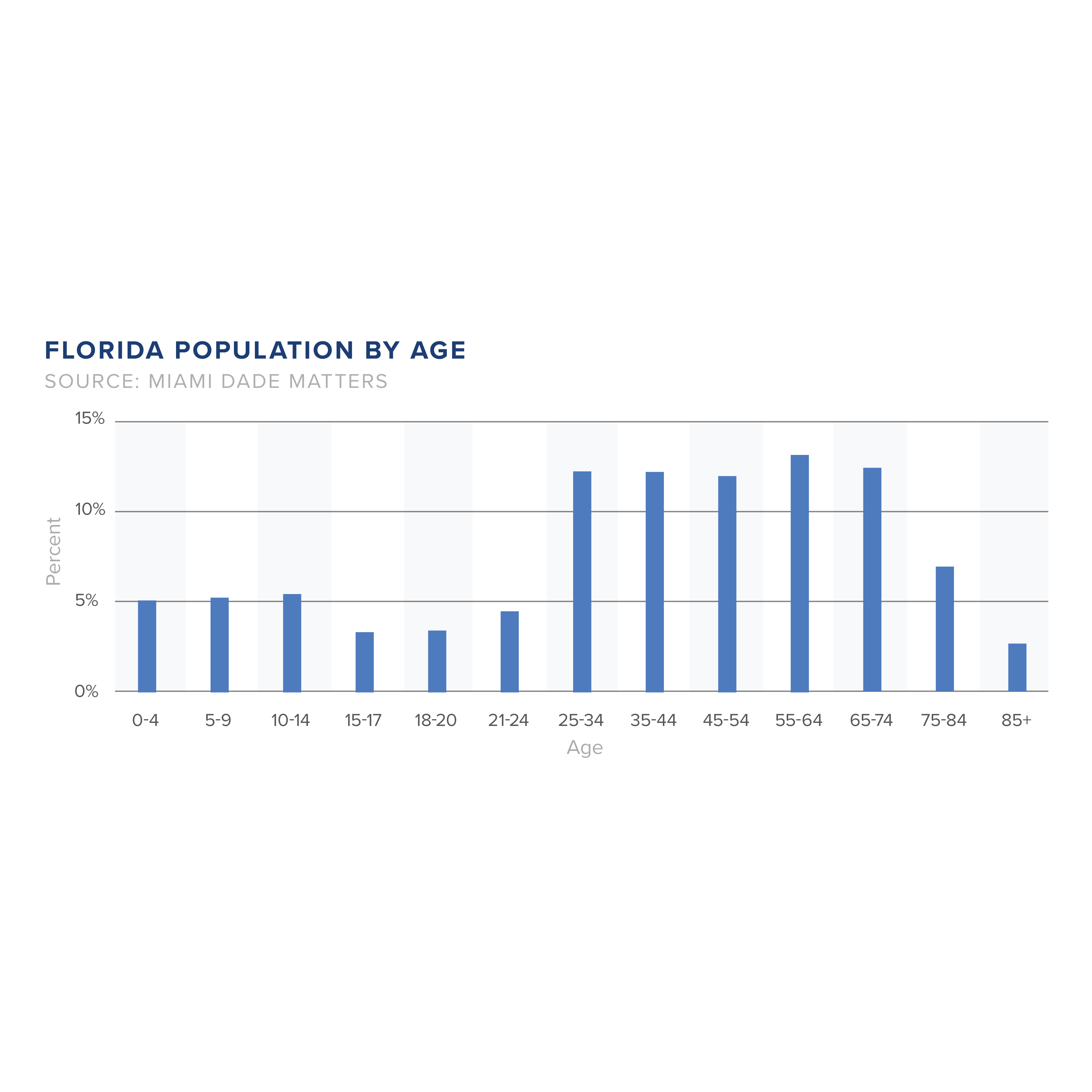How Population Growth in Florida Impacts Healthcare
Population growth in Florida has experienced unprecedented growth in recent years. According to data from USA Facts, the state’s population has increased consecutively between 2010 and 2022. The average annual growth rate is 1.4%. This surge, making Florida the nation’s fastest-growing state, has far-reaching implications for various commercial real estate sectors, particularly healthcare.
Florida’s population gains since 1946 have been impressive; its 2022 population was over nine times its 1946 population of 2.44 million, according to the U.S. Census Bureau.
Population Growth in Florida Statistics
The population boom in Florida is nothing short of remarkable. Between 2010 and 2022, the state’s population grew by 18% from the 18.8 million people who lived there in 2010. In comparison, the entire U.S. population grew by 7.7% during the same period, highlighting Florida’s exceptional growth trajectory. The most significant annual increase, a noteworthy 2%, occurred between 2015 and 2016.
In 2023, the state’s population was approximately 22.6 million, a 1.61% change from 2022, according to CBS News Miami.
According to Stefen Rayer, a population program director with the Bureau of Economic and Business Research at the University of Florida, Florida’s population growth is the highest number it has ever been. He attributed this increase to the number of people moving to the state from elsewhere in the country. “Population growth is still growing strong in the state. Slightly more than the year before, but still, if you compare long-term averages, which have been just under 300,000, it’s been really remarkably strong,” said Raider in a November 2023 meeting.
In a recent meeting, Senate President Kathleen Passidomo stated, “Our estimates suggest that over the next five years, the population in Florida will grow by almost 300,000 new residents per year, over 800 per day. That is like adding a city slightly smaller than Orlando but larger than St. Petersburg every year.”
According to the U.S. Census Bureau’s American Community Survey, the influx of people moving to Florida has been driven primarily by those in the 60 to 69 year old age group. At the same time, the second largest group was people ages 50 to 59. This is essential to highlight because with an older demographic of residents comes a higher demand for healthcare access and facilities, further emphasizing why population growth in Florida has and will continue to dramatically affect the state’s healthcare industry.

Mental Healthcare Challenges Brought on By Population Growth in Florida
As Florida’s population growth continues, so does the demand for mental healthcare services. The growing density, coupled with socioeconomic disparities and limited access to quality mental healthcare, has resulted in an alarming increase in mental health disorders. Factors such as isolation, stress, and anxiety are exacerbated by the rapid population growth in Florida, necessitates urgent attention to address the mental health needs of residents.
Data on Mental Health in Florida
According to FL Health Charts, the percentage of Florida adults who reported having poor mental health 14 or more times in the previous 30 days when surveyed has increased. In 2007, 9.70% of these adults had poor mental health, and rose to 12.3% in 2020. This shows a correlation between the rise of population growth in Florida and an increase in poor mental health across the state.
How the State is Responding
In response to population growth and rising mental healthcare challenges, the state has initiated a plan to enhance and expand mental healthcare services. To boost accessibility to mental health resources, healthcare providers and organizations are actively working to establish more mental health clinics and facilities, focusing on underserved areas. This strategic approach aims to provide the growing population in Florida with improved access to professionals capable of diagnosing and treating mental health disorders effectively.
The Role of Telehealth
Additionally, adopting telehealth services has proven to be a valuable remedy, especially in rural and remote communities. Through telehealth platforms, individuals can conveniently receive mental health consultations and therapy sessions from the comfort of their homes. This technological advancement has significantly mitigated access barriers, such as transportation challenges or limited resources. In tandem with service expansion, there has been an effort to diminish the stigma associated with mental health. Public awareness campaigns, educational programs, and lobbying efforts play critical roles in enlightening the public and encouraging acceptance and understanding. These endeavors aim to empower individuals to seek help without the apprehension of judgment or discrimination.
Economic & Employment Contributions of Hospitals
A report titled “Economic Contributions of Florida Hospitals and Affiliated Healthcare Businesses in 2021” emphasizes the crucial role of hospitals in the state’s overall economy. Florida’s hospitals are not only essential for healthcare but also serve as economic pillars and engines for population growth. Each hospital job in Florida supports 1.73 additional jobs in the state, contributing to a substantial economic impact.
Hospitals and affiliated healthcare businesses already play a vital role in employment across various regions in Florida. According to the 2021 report, the Orlando area led with 358,396 jobs, followed by Miami-Ft. Lauderdale, Tampa-St. Petersburg, Jacksonville, and other major cities. Physician offices experienced the most significant job growth, with 320,774 jobs, reflecting the increasing demand for healthcare services. Population growth in Florida drives the need for additional hospitals and facilities, resulting in a higher employment rates.
Takeaways
Florida’s remarkable population growth brings both opportunities and challenges for the healthcare industry. As the state attracts new residents, addressing the evolving healthcare needs and ensuring sustainability of infrastructure is paramount. Balancing growth with providing quality healthcare services will be crucial for maintaining the well-being of Florida’s diverse and expanding population.









